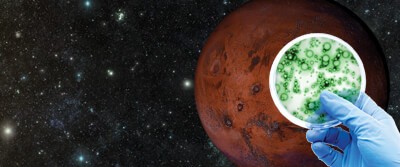Space Algae Could Feed a Trip to Mars

By Mike Howie
It may seem unlikely, but there are a few terrestrial organisms that can survive in outer space. Lichens, bacteria and tardigrades have weathered the harsh conditions before, and now researchers have added two more species to the list: algae from the Sphaerocystis species and cyanobacteria from the Nostoc species.
As part of the Biology and Mars Experiment, which aims to help us understand the extent to which terrestrial life can survive in space for a possible trip to Mars, Dr. Thomas Leya and his team from the Fraunhofer Institute in Potsdam, Germany sent the two species to the International Space Station (ISS), where they were attached to the outside of the craft for 16 months. Through studying the algae and cyanobacteria in the lab, the team had already learned that both are mostly unharmed by long-term desiccation stress, extreme temperatures and radiation. The native homes of each — Norway and Antarctica, respectively — are part of why the species do so well in the cold, and why they were selected for the experiment. The researchers did all the work they could in the lab, but the samples had to make a trip to the space station to experience the full, extreme conditions of near-Earth orbit.
A Long, Cold, Irradiated Orbit
Once attached to the space station, the specimens were exposed to a near vacuum, temperatures ranging from -4°F to 116°F, and constant ultraviolet radiation with only a neutral-density filter, which reduced the effects of radiation, for protection. The researchers suspected that the organisms would survive the cold and UVA/UVB radiation, but they were particularly interested to see how the organisms reacted to UVC radiation, which is extremely harmful. Surprisingly, the algal strains were left unscathed by the radiation, and moreover survived well in the dryness of space.
The results of the experiment are another step forward for an eventual mission to Mars. Studying how and to what extent the algae’s DNA was damaged will help us learn how to protect our own DNA against UV radiation and how to grow food on the Red Planet — both of which will be essential for an extended stay away from Earth.
Beyond aiding our ambitions for space travel, the findings could also help us learn how life on our pale-blue dot began. They support the panspermia theory, which suggests that early life forms may have made their way to Earth on meteorites.
Discussion Questions
- How else could the findings help improve our lives?
- Would you want to live on Mars? Why or why not?
- Cyanobacteria
- UV Radiation
- Vacuum
